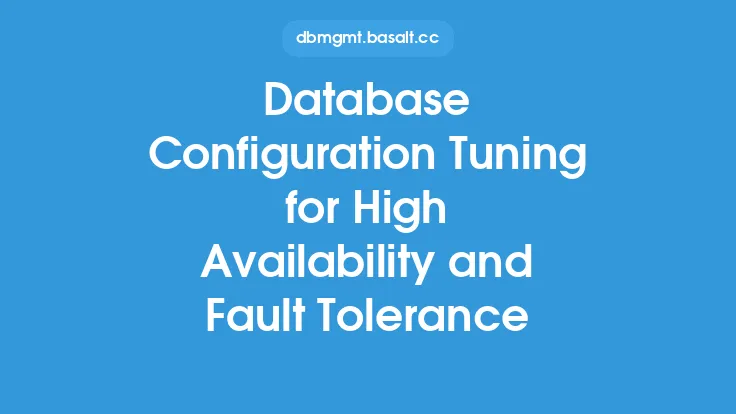Database maintenance is a critical aspect of ensuring the overall health and performance of a database. One key component of proactive maintenance is the collection and analysis of database statistics and monitoring. This involves gathering data on various database metrics, such as query execution times, disk usage, and system resource utilization, to identify potential issues before they become major problems. In this article, we will delve into the world of database statistics and monitoring, exploring the different types of statistics that can be collected, the tools and techniques used to collect and analyze them, and the benefits of proactive maintenance.
Introduction to Database Statistics
Database statistics refer to the collection of data that provides insight into the performance and behavior of a database. This data can include metrics such as query execution times, disk usage, memory usage, and system resource utilization. By collecting and analyzing these statistics, database administrators can identify trends, patterns, and anomalies that may indicate potential issues or areas for improvement. There are several types of database statistics that can be collected, including:
- Query statistics: These provide information on query execution times, query plans, and index usage.
- System statistics: These provide information on system resource utilization, such as CPU usage, memory usage, and disk usage.
- Storage statistics: These provide information on disk usage, storage capacity, and storage performance.
- Network statistics: These provide information on network traffic, network latency, and network errors.
Tools and Techniques for Collecting Database Statistics
There are several tools and techniques that can be used to collect database statistics, including:
- Built-in database tools: Most databases come with built-in tools for collecting and analyzing statistics, such as SQL Server's Dynamic Management Views (DMVs) or Oracle's Automatic Workload Repository (AWR).
- Third-party tools: There are many third-party tools available that can be used to collect and analyze database statistics, such as Nagios, SolarWinds, and Quest Software's Foglight.
- Scripting and programming: Database administrators can also use scripting and programming languages, such as Python or PowerShell, to collect and analyze database statistics.
- Cloud-based services: Many cloud-based services, such as Amazon CloudWatch or Google Cloud Monitoring, provide tools and services for collecting and analyzing database statistics.
Analyzing Database Statistics
Once database statistics have been collected, they must be analyzed to identify trends, patterns, and anomalies. This can be done using a variety of techniques, including:
- Visual analysis: Using charts, graphs, and other visualizations to identify trends and patterns in the data.
- Statistical analysis: Using statistical techniques, such as regression analysis or time series analysis, to identify correlations and trends in the data.
- Threshold-based analysis: Setting thresholds for specific metrics and alerting when those thresholds are exceeded.
- Machine learning-based analysis: Using machine learning algorithms to identify patterns and anomalies in the data.
Benefits of Proactive Maintenance
Proactive maintenance is critical for ensuring the overall health and performance of a database. By collecting and analyzing database statistics, database administrators can identify potential issues before they become major problems. This can help to:
- Improve database performance: By identifying and addressing performance issues before they become major problems, database administrators can improve the overall performance of the database.
- Reduce downtime: By identifying and addressing potential issues before they cause downtime, database administrators can reduce the amount of downtime and improve overall system availability.
- Improve data integrity: By identifying and addressing issues related to data integrity, database administrators can improve the overall quality and accuracy of the data.
- Reduce costs: By identifying and addressing potential issues before they become major problems, database administrators can reduce the costs associated with downtime, data recovery, and system maintenance.
Best Practices for Database Statistics and Monitoring
There are several best practices that database administrators can follow to ensure effective database statistics and monitoring, including:
- Collecting statistics regularly: Database statistics should be collected on a regular basis to ensure that the data is up-to-date and accurate.
- Analyzing statistics regularly: Database statistics should be analyzed on a regular basis to identify trends, patterns, and anomalies.
- Setting thresholds: Thresholds should be set for specific metrics to alert when those thresholds are exceeded.
- Using automation: Automation should be used to collect and analyze database statistics, as well as to perform routine maintenance tasks.
- Using visualization: Visualization should be used to present database statistics in a clear and concise manner, making it easier to identify trends and patterns.
Common Challenges and Pitfalls
There are several common challenges and pitfalls that database administrators may encounter when collecting and analyzing database statistics, including:
- Data overload: Collecting too much data can be overwhelming and make it difficult to identify trends and patterns.
- Data quality issues: Poor data quality can make it difficult to analyze and interpret database statistics.
- Lack of standardization: Lack of standardization can make it difficult to compare and contrast database statistics across different systems and databases.
- Insufficient resources: Insufficient resources, such as CPU or memory, can make it difficult to collect and analyze database statistics.
- Security issues: Security issues, such as unauthorized access or data breaches, can compromise the integrity of database statistics.
Conclusion
Database statistics and monitoring are critical components of proactive maintenance, allowing database administrators to identify potential issues before they become major problems. By collecting and analyzing database statistics, database administrators can improve database performance, reduce downtime, improve data integrity, and reduce costs. By following best practices, such as collecting statistics regularly, analyzing statistics regularly, and using automation, database administrators can ensure effective database statistics and monitoring. However, common challenges and pitfalls, such as data overload, data quality issues, and lack of standardization, must be addressed to ensure the accuracy and effectiveness of database statistics and monitoring.





